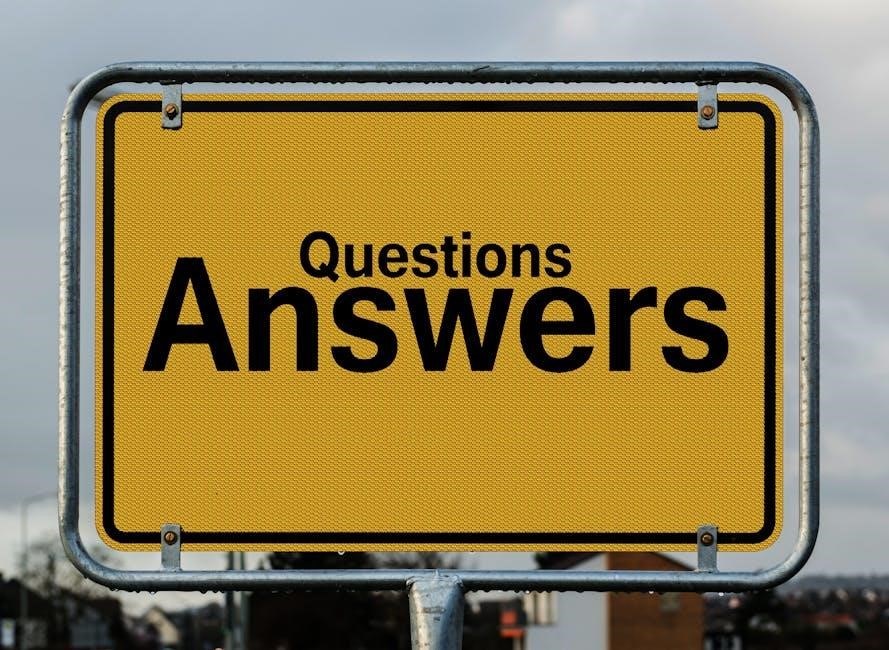The 12 Week Year PDF: A Comprehensive Guide
The 12 Week Year PDF offers a unique productivity approach‚ enabling users to achieve more in 12 weeks than others manage in a year‚ as highlighted by LitRes․
Resources like Bookey and the official 12weekyear․com website provide access to templates and community support for effective implementation of this system․

What is the 12 Week Year?
The 12 Week Year is a focused productivity methodology‚ detailed in the book by Brian P․ Moran and Michael Lennington‚ designed to dramatically accelerate goal achievement․ Unlike traditional annual planning‚ it structures work into twelve distinct 12-week cycles․

This system‚ often accessed via a 12 Week Year PDF‚ emphasizes intense focus on a limited number of high-priority goals within each cycle․ It’s about shifting from long-term‚ often vague‚ plans to short‚ actionable sprints․ The core idea is to combat the tendency for yearly plans to become forgotten‚ as noted in online discussions․
The methodology encourages breaking down large objectives into manageable weekly tasks‚ fostering accountability and discipline․ Resources available at 12weekyear․com and through platforms like Bookey support users in understanding and implementing this powerful system․
The Core Concept: Time as a Finite Resource
The 12 Week Year fundamentally reframes our perception of time‚ treating it as a strictly limited resource․ Unlike the seemingly endless expanse of a calendar year‚ the 12-week cycle creates a sense of urgency and focus․ This scarcity mindset‚ detailed within the 12 Week Year PDF‚ compels prioritization and eliminates wasted effort․
The system challenges the conventional approach of spreading attention across numerous goals simultaneously․ Instead‚ it advocates concentrating energy on “Big Rocks” – the critical priorities that will yield the most significant results․
This concept‚ readily available through resources like 12weekyear․com‚ acknowledges that time is non-renewable‚ demanding intentionality in how we allocate it․ By embracing this finite perspective‚ individuals can unlock a higher level of productivity and achieve more impactful outcomes․
The Problem with Traditional Goal Setting
Traditional annual planning often leads to diluted focus and unrealized ambitions․ The 12 Week Year PDF identifies a core issue: long-term goals frequently become distant and abstract‚ losing their motivational power over time․ Many plans‚ meticulously crafted‚ end up “forgotten in binders‚” lacking consistent action and accountability․
The extended timeframe encourages procrastination and allows for distractions to derail progress․ This contrasts sharply with the 12-week sprints‚ which foster a sense of immediacy and commitment․
The system‚ as detailed on 12weekyear․com‚ addresses this by breaking down large objectives into manageable‚ time-bound segments‚ ensuring consistent forward momentum and preventing the stagnation often associated with conventional goal-setting methods․
Benefits of Using a 12 Week Year
Implementing the 12 Week Year PDF system yields significant advantages in productivity and goal attainment․ The core benefit lies in its ability to concentrate effort‚ driving results far exceeding those achieved through traditional methods․ Users report accomplishing more in a quarter than previously managed in an entire year․
The focused sprints‚ as promoted on 12weekyear․com‚ cultivate discipline and accountability․ By emphasizing “actionable steps‚” the system transforms abstract aspirations into concrete tasks․
This approach minimizes wasted time and maximizes impact‚ fostering a proactive mindset․ The system’s structure‚ detailed in resources like Bookey‚ empowers individuals to take control of their time and achieve substantial progress․
Increased Focus and Prioritization
The 12 Week Year PDF methodology dramatically enhances focus by shifting from annual planning to concentrated 12-week cycles․ This framework compels users to identify “Big Rocks”—critical priorities—demanding immediate attention․ Traditional plans‚ often forgotten‚ are replaced with actionable steps‚ as noted in online discussions․
This prioritization process eliminates distractions and ensures resources are allocated to the most impactful activities․ The system‚ detailed on 12weekyear․com‚ encourages a weekly review to maintain alignment with overarching goals․
By breaking down the year into manageable sprints‚ the 12 Week Year fosters a sense of urgency and minimizes the tendency for tasks to fall by the wayside․
Enhanced Accountability and Discipline
Utilizing the 12 Week Year PDF system cultivates heightened accountability through its structured approach․ The defined 12-week sprints necessitate consistent progress tracking and regular evaluation of “Big Rocks‚” fostering self-discipline․ Unlike traditional‚ often vague‚ annual plans‚ this method demands concrete weekly actions․
The framework‚ accessible via resources like 12weekyear․com‚ encourages proactive problem-solving and adaptation to unforeseen obstacles․ This consistent cycle of planning‚ execution‚ and review builds a strong sense of ownership and commitment․
The focused nature of the 12 Week Year minimizes procrastination and promotes a results-oriented mindset‚ driving sustained discipline․
Where to Find the 12 Week Year PDF
Accessing the 12 Week Year PDF is readily achievable through several avenues․ The official source‚ www․12weekyear․com‚ provides comprehensive resources‚ including potential PDF downloads and access to the community․ LitRes‚ an electronic book service‚ offers the book‚ “The 12 Week Year‚” for purchase and subsequent PDF download․
Furthermore‚ various third-party platforms may host PDF versions‚ though verifying their legitimacy is crucial․ Tools like PDFescape or Smallpdf can assist with editing PDFs obtained from different sources․
Exploring online searches for “12 week year pdf” will yield numerous results‚ but caution regarding copyright and source reliability is advised․
Official Website and Resources (www․12weekyear․com)
www․12weekyear․com serves as the central hub for all things related to the 12 Week Year methodology․ The site offers direct access to information about the system‚ including details on the core concepts and benefits of utilizing focused 12-week sprints for goal achievement․
Users can join the 12 Week Year community through the “gettingstarted” section‚ a free resource providing valuable support and connection with fellow practitioners․ While direct PDF downloads aren’t explicitly mentioned‚ the website likely provides links to purchase the book in PDF format․
Expect to find templates and resources designed to facilitate implementation of the system‚ enhancing productivity and focus․
Third-Party PDF Downloads and Availability
Finding a legitimate‚ free 12 Week Year PDF download can be challenging․ While various websites may offer downloads‚ caution is advised due to potential copyright issues and the risk of malware․ Several sources mention the availability of the book through services like LitRes‚ offering a legal avenue to acquire the material․
Users seeking PDF editing capabilities may explore tools like PDFescape or Smallpdf to modify the document after obtaining it legally․ However‚ relying on unofficial sources carries inherent risks regarding file integrity and authenticity․
Prioritizing authorized purchase channels ensures access to a genuine and safe copy of “The 12 Week Year․”
Key Components of the 12 Week Year System
The core of the 12 Week Year system revolves around a structured approach to goal achievement‚ breaking down a year into three focused 12-week sprints․ This methodology emphasizes actionable steps‚ moving away from traditional plans often forgotten in binders․ A crucial phase is “Vision Week‚” dedicated to defining long-term objectives․
“Planning Week” follows‚ dissecting the year into manageable segments․ Subsequently‚ “Execution Weeks” demand intense focus․ The system highlights “Big Rocks”—critical priorities demanding immediate attention․ Effective time blocking and scheduling are integral to success‚ as promoted on 12weekyear;com․
Vision Week: Defining Your Long-Term Goals
Vision Week‚ a foundational element of the 12 Week Year system‚ is dedicated to establishing a clear‚ compelling long-term vision․ This isn’t merely goal setting; it’s about articulating what success truly looks like‚ extending beyond the immediate 12-week sprints․ It’s a period for expansive thinking‚ identifying aspirations‚ and defining the desired future state․
The process encourages a broad perspective‚ prompting individuals to consider their ambitions across all life areas․ This clarity then informs the subsequent Planning Week‚ ensuring all actions align with the overarching vision․ Without a robust vision‚ the focused execution risks being misdirected‚ diminishing overall impact․
Planning Week: Breaking Down the Year
Planning Week follows Vision Week‚ translating long-term aspirations into actionable 12-week plans․ This phase involves dissecting the year into these focused sprints‚ recognizing that traditional plans often remain unrealized․ The core principle is to avoid overwhelming yearly goals‚ instead concentrating on what can be realistically achieved within a defined timeframe․

Effective planning identifies “Big Rocks” – the critical priorities that will drive significant progress towards the vision․ These aren’t tasks‚ but rather outcomes․ The 12 Week Year emphasizes a structured approach‚ ensuring each sprint contributes meaningfully to the overall yearly objectives‚ fostering consistent advancement․
Execution Weeks: Focused 12-Week Sprints
Execution Weeks are the heart of the 12 Week Year system‚ representing concentrated 12-week periods dedicated to achieving defined goals․ These sprints aren’t simply about working harder; they’re about working smarter through intense focus and prioritization․ Long-term results are built “one week at a time‚” demanding consistent effort and accountability․
During these weeks‚ time blocking and scheduling become crucial․ The system encourages a proactive approach to managing time‚ ensuring that “Big Rocks” receive dedicated attention․ Maintaining momentum is key‚ requiring diligent tracking of progress and a willingness to adapt when facing unexpected obstacles․
The Importance of “The Big Rocks”
Within the 12 Week Year framework‚ “The Big Rocks” represent the absolutely critical priorities that will drive the most significant impact towards your overarching vision․ Identifying these isn’t about listing everything you want to do‚ but discerning what truly needs to be done to achieve substantial progress․
A well-structured 12-week plan emphasizes actionable steps tied to these key priorities․ Focusing on these “Big Rocks” prevents wasted effort on less important tasks․ This approach ensures that your time and energy are strategically allocated‚ maximizing results within the limited timeframe of each 12-week sprint․
Identifying Critical Priorities
Successfully implementing the 12 Week Year hinges on accurately identifying your critical priorities – those “Big Rocks” that will propel you towards your vision․ This process demands ruthless honesty and a clear understanding of what truly matters‚ avoiding the trap of simply listing desired outcomes․
Traditional planning often leads to forgotten goals‚ whereas a focused 12-week plan emphasizes actionable steps․ Prioritization involves asking: “What single action‚ if completed‚ would create the greatest positive impact?” Focusing on these key areas ensures efficient resource allocation and maximizes progress within each sprint․
Time Blocking and Scheduling

Once critical priorities are defined within the 12 Week Year framework‚ effective time blocking and scheduling become paramount․ This isn’t merely about filling a calendar; it’s about deliberately allocating dedicated‚ uninterrupted blocks of time to work on those “Big Rocks․”
The system emphasizes that long-term results are built through consistent‚ focused effort‚ “one week at a time․” Scheduling should reflect this‚ protecting priority tasks from distractions․ Utilizing digital tools for tracking progress‚ alongside the 12 Week Year templates‚ further enhances accountability and ensures consistent execution throughout each 12-week sprint․
Tools and Templates for Implementation
Successfully implementing the 12 Week Year relies heavily on utilizing appropriate tools and templates․ Numerous options exist‚ ranging from free resources to paid premium offerings․ The official 12weekyear․com website provides a starting point‚ alongside a thriving community offering support and shared experiences․
Beyond the official resources‚ various third-party templates are available‚ including those for one-year planning and specifically for the 12 Week Year itself․ Digital tools‚ like those for progress tracking‚ complement the system․ Even basic PDF editing tools‚ such as PDFescape or Smallpdf‚ can be used to customize the Field Guide․
12 Week Year Templates (Free and Paid)
A variety of 12 Week Year templates are readily available‚ catering to different needs and budgets․ Pinterest showcases numerous inspirational ideas and template designs․ Free templates offer a cost-effective entry point for beginners‚ allowing exploration of the system’s core principles without financial commitment․
Conversely‚ paid templates often provide more sophisticated features‚ enhanced customization options‚ and dedicated support․ Resources like the official website and third-party providers offer these premium options․ Utilizing these templates streamlines the planning process‚ ensuring adherence to the 12 Week Year methodology and maximizing productivity․
Using Digital Tools for Tracking Progress
Effectively tracking progress is crucial when implementing the 12 Week Year system․ While the core methodology can be applied with traditional methods‚ digital tools significantly enhance monitoring and accountability․ PDF editing capabilities‚ utilizing tools like PDFescape or Smallpdf‚ allow for direct annotation and updates within the 12 Week Year Field Guide․
Furthermore‚ integrating with broader project management or task management software provides a centralized hub for all activities․ This digital approach facilitates data-driven decision-making‚ enabling users to identify roadblocks and adjust strategies for optimal results throughout their 12-week sprints․
The 12 Week Year Field Guide
The 12 Week Year Field Guide serves as a practical companion to the core concepts presented in the book․ It’s designed to facilitate the planning and execution phases of the system‚ offering structured templates and prompts for defining vision‚ breaking down goals‚ and scheduling weekly activities․ The guide contains images and elements within the PDF format․
Its purpose is to move beyond theoretical understanding and into tangible action․ Users can leverage the Field Guide to maintain focus on “Big Rocks” and ensure consistent progress throughout each 12-week cycle‚ ultimately maximizing productivity and achieving significant results․
Understanding the Field Guide’s Role
The 12 Week Year Field Guide isn’t merely a collection of templates; it’s a crucial tool for translating the system’s principles into daily practice․ It bridges the gap between the conceptual framework of the book and the practical realities of goal achievement․ The PDF format allows for easy access and repeated use throughout the year․
Its role centers on providing a structured environment for vision week‚ planning week‚ and the subsequent execution weeks․ By actively engaging with the Field Guide‚ users reinforce their commitment and maintain a clear line of sight to their most important priorities‚ fostering discipline and accountability․
PDF Editing Capabilities for the Field Guide
While the 12 Week Year Field Guide is designed for focused execution‚ some users may desire customization․ Fortunately‚ several tools facilitate PDF editing․ Options range from basic annotation features within standard PDF readers to more robust editing suites․
Free online tools like PDFescape and Smallpdf offer fundamental editing capabilities‚ allowing for form filling and basic modifications․ For more extensive changes – such as altering template layouts or adding personalized notes – dedicated PDF editors may be necessary․ These tools empower users to tailor the Field Guide to their specific needs and workflows․
Common Challenges and How to Overcome Them
Implementing the 12 Week Year isn’t without potential hurdles․ Maintaining momentum during the intense execution phase is a frequent challenge; consistent review of “Big Rocks” and weekly progress checks are crucial․ Unexpected obstacles inevitably arise‚ demanding flexibility and a willingness to re-prioritize tasks within the sprint․
Another common issue is scope creep – adding too many goals mid-cycle․ Strict adherence to the initial plan‚ coupled with a “parking lot” for new ideas‚ helps mitigate this․ Remember‚ the 12 Week Year emphasizes focused action‚ not endless planning․

Maintaining Momentum During Execution
Sustaining drive throughout the 12-week sprints requires deliberate effort․ Regularly revisiting your vision and the compelling reasons why you chose these goals is paramount․ The 12 Week Year system emphasizes breaking down large objectives into manageable weekly tasks‚ fostering a sense of consistent progress․

Accountability is key; consider partnering with someone for mutual support․ Leverage digital tools for tracking progress and celebrating small wins․ Remember‚ long-term results are built “one week at a time‚” as highlighted in resources related to the 12 Week Year PDF․
Dealing with Unexpected Obstacles
The 12 Week Year PDF methodology acknowledges that disruptions are inevitable․ Instead of derailing your entire plan‚ focus on adapting and re-prioritizing․ Regularly scheduled review weeks are crucial for assessing progress and making necessary adjustments to your “big rocks” – critical priorities․
Don’t allow minor setbacks to erode momentum․ The system’s emphasis on focused 12-week sprints encourages a proactive approach to problem-solving․ Recommit to your weekly tasks and leverage the accountability mechanisms built into the process․ Remember‚ flexibility within a structured framework is essential for sustained success․
The 12 Week Year vs․ Other Productivity Methods
Unlike traditional planning‚ which often results in forgotten binders‚ the 12 Week Year PDF emphasizes actionable steps and a time-bound approach․ It differs from continuous planning by creating distinct‚ focused blocks for execution․ While sharing similarities with Agile and Scrum‚ it’s tailored for individual or small team goal achievement․
The core distinction lies in its deliberate focus on a finite timeframe‚ fostering urgency and prioritization․ This contrasts with methods lacking a defined end-date․ The system’s structure‚ detailed in resources like 12weekyear․com‚ promotes consistent progress and measurable results‚ unlike less structured approaches․
Comparison with Traditional Planning
Traditional annual or long-term planning often leads to diluted focus and unfulfilled goals‚ as plans become outdated or overwhelming․ The 12 Week Year PDF directly addresses this by breaking down the year into manageable 90-day sprints․ This contrasts sharply with the broad scope of conventional methods․
Unlike yearly plans frequently relegated to forgotten binders‚ the 12 Week Year prioritizes actionable steps within a defined timeframe․ It shifts the emphasis from simply setting goals to actively achieving them․ Resources like those found on 12weekyear․com highlight this difference‚ promoting a more dynamic and results-oriented approach․

Synergies with Agile and Scrum Methodologies
The core principles of the 12 Week Year PDF demonstrate strong alignment with Agile and Scrum methodologies‚ both known for iterative development and focused sprints․ Like Agile‚ the 12 Week Year emphasizes breaking down large objectives into smaller‚ achievable 12-week cycles‚ fostering adaptability and continuous improvement․
The concept of “Execution Weeks” mirrors Scrum’s sprints‚ demanding concentrated effort and regular review․ Both systems prioritize delivering tangible results within short‚ defined periods․ Utilizing the 12weekyear․com resources can help integrate these approaches‚ creating a powerful synergy for enhanced productivity and project management․
Success Stories and Case Studies

While specific‚ detailed case studies directly linked to the 12 Week Year PDF aren’t readily available in the provided snippets‚ the methodology’s impact is evident in its growing community and positive user testimonials․ Individuals are reporting significant gains in focus and accomplishment‚ achieving more in a compressed timeframe․
The emphasis on actionable steps‚ as opposed to traditional‚ often-forgotten plans‚ contributes to real-world results․ Users accessing resources from 12weekyear․com and utilizing templates are experiencing increased accountability and discipline․ The system’s effectiveness lies in its ability to translate ambition into concrete‚ measurable progress․
Real-World Applications of the 12 Week Year
The 12 Week Year PDF methodology finds application across diverse spheres‚ from personal goal attainment to professional project management․ Individuals leverage the system to accelerate progress on fitness objectives‚ skill development‚ or side hustles․ Businesses utilize it for launching new products‚ increasing sales‚ or improving team performance․
The core principle – focusing on “Big Rocks” and breaking down long-term visions into manageable 12-week sprints – proves adaptable to various contexts․ The system’s emphasis on weekly planning and consistent execution fosters a proactive approach‚ driving tangible outcomes in both personal and professional life․
Impact on Personal and Professional Life

Implementing the 12 Week Year PDF system demonstrably impacts both personal and professional realms․ Users report heightened focus‚ reduced procrastination‚ and a greater sense of control over their time․ This translates to increased productivity and a more fulfilling lifestyle‚ moving beyond traditional‚ often-forgotten plans․
Professionally‚ the methodology fosters accountability and drives results‚ leading to career advancement and business growth․ Personally‚ it empowers individuals to achieve long-held aspirations‚ improving overall well-being․ The system’s structured approach minimizes overwhelm and maximizes output‚ creating a positive ripple effect across all life areas․


























































































